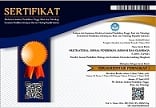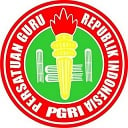Aktivitas fisik dan kenikmatan berolahraga pelajar Indonesia
Abstract
Beberapa bukti menyatakan bahwa kegiatan fisik yang dilakukan secara konsisten dipengaruhi oleh kenikmatan dalam melakukan kegiatan fisik tersebut. Tujuan dari penelitian ini adalah untuk menghasilkan pengetahuan tentang kegiatan fisik dan kenikmatan berolahraga berdasarkan gender, urbanitas dan jenjang pendidikan. Penelitian ini merupakan penelitian komparatif korelasional. Populasi penelitian ini terdiri dari seluruh pelajar di Indonesia. Besar sampel penelitian ini adalah 7207 siswa yang terdiri dari 1224 pelajar SD, 3023 Pelajar SMP, 2960 pelajar SMA. Temuan penelitian ini adalah sebagai berikut: Aktivitas fisik tidak memenuhi kriteria baik, kenikmatan berolahragamemenuhi kriteria baik, terdapat perbedaan kegiatan fisik berdasarkan gender dan jenjang pendidikan, tidak terdapat perbedaan kegiatan fisik berdasakan urbanitas, terdapat perbedaan kenikmatan berolahraga berdasarkan gender dan jenjang pendidikan, tidak terdapat perbedaan kenikmatan berolahraga berdasarkan urbanitas dan jenjang pendidikan, tidak ada perbedaan kenikmatan berolahraga berdasarkan gender, serta terdapat hubungan kegiatan fisik dan kenikmatan berolahraga pelajar Indonesia
Full Text:
PDFReferences
Abel, T., Graf, N., & Niemann, S. (2001). Gender Bias in the Assessment of Physical Activity in Population Studies. Sozial-Und Praventivmedizin, 46(4), 268-272. https://doi.org/10.1007/BF01593182
Almeida, G. T., & Rogatto, G. P. (2007). Efeitos do Método Pliométrico de Treinamento Sobre a Força Explosiva, Agilidade e Velocidade de Deslocamento de Jogadores de Futsal. Revista Brasileira de Educação Física, Esporte, Lazer e Dança, 2(1), 23-38. https://ojs.fiepbulletin.net/fiepbulletin/article/view/2245
Azevedo, M. R., Araújo, C. L. P., Reichert, F. F., Siqueira, F. V., da Silva, M. C., & Hallal, P. C. (2007). Gender Differences in Leisure-Time Physical Activity. International Journal of Public Health, 52(1), 8-15. https://doi.org/10.1007/s00038-006-5062-1
Barr-Anderson, D. J., Neumark-Sztainer, D., Lytle, L., Schmitz, K. H., Ward, D. S., Conway, T. L., Pratt, C., Baggett, C. D., & Pate, R. R. (2008). But I Like PE: Factors Associated with Enjoyment of Physical Education Class in Middle School Girls. Research Quarterly for Exercise and Sport, 79(1), 18-27. https://doi.org/10.1080/02701367.2008.10599456
Basso, J. C., & Suzuki, W. A. (2017). The Effects of Acute Exercise on Mood, Cognition, Neurophysiology, and Neurochemical Pathways: A Review. Brain Plasticity, 2(2), 127-152. https://doi.org/10.3233/bpl-160040
Brown, D. (2014). Negative Experiences in Physical Education Class and Avoidance of Exercise. Master's Theses. 55. https://doi.org/10.58809/SDEQ1058
Brustad, R. J. (1993). Who Will go Out and Play? Parental and Psychological Influences on Children’s Attraction to Physical Activity. Human Kinetics Publishers, Inc., 5, 21022
Burton, N. W., & Turrell, G. (2000). Occupation, Hours Worked, and Leisure-Time Physical Activity. Preventive Medicine, 31(6), 673-681. https://doi.org/10.1006/pmed.2000.0763
Cairney, J., Kwan, M. Y. W., Velduizen, S., Hay, J., Bray, S. R., & Faught, B. E. (2012). Gender, Perceived Competence and the Enjoyment of Physical Education in Children: A Longitudinal Examination. International Journal of Behavioral Nutrition and Physical Activity, 9, 1-8. https://doi.org/10.1186/1479-5868-9-26
Clarke, A. E., & Janssen, I. (2021). A Compositional Analysis of Time Spent in Sleep, Sedentary Behaviour and Physical Activity with All-Cause Mortality Risk. International Journal of Behavioral Nutrition and Physical Activity, 18(1), 1-12. https://doi.org/10.1186/s12966-021-01092-0
Eikemo, T. A., Hoffmann, R., Kulik, M. C., Kulhánová, I., Toch-Marquardt, M., Menvielle, G., Looman, C., Jasilionis, D., Martikainen, P., Lundberg, O., & Mackenbach, J. P. (2014). How Can Inequalities in Mortality be Reduced? A Quantitative Analysis of 6 Risk Factors in 21 European Populations. PLoS ONE, 9(11). https://doi.org/10.1371/journal.pone.0110952
Ekelund, U., Tarp, J., Steene-Johannessen, J., Hansen, B. H., Jefferis, B., Fagerland, M. W., Whincup, P., Diaz, K. M., Hooker, S. P., Chernofsky, A., Larson, M. G., Spartano, N., Vasan, R. S., Dohrn, I. M., Hagströmer, M., Edwardson, C., Yates, T., Shiroma, E., Anderssen, S. A., & Lee, I. M. (2019). Dose-Response Associations between Accelerometry Measured Physical Activity and Sedentary Time and All Cause Mortality: Systematic Review and Harmonised Meta-Analysis. The BMJ, 366, 1-10. https://doi.org/10.1136/bmj.l4570
Ensari, I., Sandroff, B. M., & Motl, R. W. (2016). Effects of Single Bouts of Walking Exercise and Yoga on Acute Mood Symptoms in People with Multiple Sclerosis. International Journal of MS Care, 18(1), 1-8. https://doi.org/10.7224/1537-2073.2014-104
Fan, J. X., Wen, M., & Kowaleski-Jones, L. (2014). Rural-urban differences in objective and subjective measures of physical activity: Findings from the National Health and Nutrition Examination Survey (NHANES) 2003-2006. Preventing Chronic Disease, 11, 8–10. https://doi.org/10.5888/pcd11.140189
Firtanto, A. D., & Maksum, A. (2022). Pola Aktivitas Fisik Siswa SMP pada Masa Pandemi Covid-19. JPOK: Jurnal Pendidikan Olahraga dan Kesehatan, 10(1), 91-95. https://ejournal.unesa.ac.id/index.php/jurnal-pendidikan-jasmani/article/view/42154
Forbes, C. C., Yu, Z. M., Cui, Y., DeClercq, V., Grandy, S. A., Parker, L., Sweeney, E., Dummer, T. J. B., & Keats, M. R. (2020). Rural-Urban Disparities in Total Physical Activity, Body Composition, and Related Health Indicators: An Atlantic PATH Study. The Journal of Rural Health, 36(1), 111-119. https://doi.org/10.1111/jrh.12363
Fox, K. (1991). Motivating Children for Physical Activity: Towards a Healthier Future. Journal of Physical Education, Recreation & Dance, 62(7), 34-38. https://doi.org/10.1080/07303084.1991.10603999
Gabriel, K. K. P., Morrow, J. R., Jr., & Woolsey, A. T. (2012). Framework for Physical Activity as a Complex and Multidimensional Behavior. Journal of Physical Activity and Health, 9(s1), S11-S18. Retrieved Dec 18, 2024, from https://doi.org/10.1123/jpah.9.s1.s11
Garn, A. C., & Cothran, D. J. (2006). The Fun Factor in Physical Education. Journal of Teaching in Physical Education, 25(3), 281-297. https://doi.org/10.1123/jtpe.25.3.281
Gill, D.L., Gross, J.B., & Huddleston, S. (1983). Participation Motivation in Youth Sports. International Journal of Sport Psychology, 14, 1-14. https://psycnet.apa.org/record/1984-09240-001
Hallal, P. C., & Siqueira, F. V. (2004). Compliance with Vigorous Physical Activity Guidelines in Brazilian Adults: Prevalence and Correlates. Journal of Physical Activity and Health, 1(4), 389-397. https://doi.org/10.1123/jpah.1.4.389
Hallal, P. C., Victora, C. G., Wells, J. C. K., & Lima, R. C. (2003). Physical Inactivity: Prevalence and Associated Variables in Brazilian Adults. Medicine and Science in Sports and Exercise, 35(11), 1894-1900. https://doi.org/10.1249/01.MSS.0000093615.33774.0E
Koran Sindo. (2022). No Title. Kebugaran Orang Indonesia Rendah, Retrieved June 20, 2022. https://nasional.sindonews.com/read/672353/15/kebugaran-orang-indonesia-rendah-1643598094?showpage=all
Lee, I. M., Shiroma, E. J., Lobelo, F., Puska, P., Blair, S. N., Katzmarzyk, P. T., Alkandari, J. R., Andersen, L. B., Bauman, A. E., Brownson, R. C., Bull, F. C., Craig, C. L., Ekelund, U., Goenka, S., Guthold, R., Hallal, P. C., Haskell, W. L., Heath, G. W., Inoue, S., … Wells, J. C. (2012). Effect of Physical Inactivity on Major Non-Communicable Diseases Worldwide: An Analysis of Burden of Disease and Life Expectancy. The Lancet, 380(9838), 219-229. https://doi.org/10.1016/S0140-6736(12)61031-9
Long, A. S., Hanlon, A. L., & Pellegrin, K. L. (2018). Socioeconomic Variables Explain Rural Disparities in US Mortality Rates: Implications for Rural Health Research and Policy. SSM - Population Health, 6(August), 72-74. https://doi.org/10.1016/j.ssmph.2018.08.009
Malina, R. M. (2001). Physical Activity and Fitness: Pathways from Childhood to Adulthood. American Journal of Human Biology, 13(2), 162-172. https://doi.org/10.1002/1520-6300(200102/03)13:2<162::AID-AJHB1025>3.0.CO;2-T
Mao, H. Y., Hsu, H. C., & Lee, S. Da. (2020). Gender Differences in Related Influential Factors of Regular Exercise Behavior among People In Taiwan In 2007: A Cross-Sectional Study. PLoS ONE, 15(1), 1-13. https://doi.org/10.1371/journal.pone.0228191
Marmot, M., Friel, S., Bell, R., Houweling, T. A., & Taylor, S. (2008). Closing the Gap in a Generation: Health Equity Through Action on the Social Determinants of Health. The Lancet, 372(9650), 1661-1669. https://doi.org/10.1016/S0140-6736(08)61690-6
Marquez, D. X., Aguinãga, S., Vásquez, P. M., Conroy, D. E., Erickson, K. I., Hillman, C., Stillman, C. M., Ballard, R. M., Sheppard, B. B., Petruzzello, S. J., King, A. C., & Powell, K. E. (2020). A Systematic Review of Physical Activity and Quality of Life and Well-Being. Translational Behavioral Medicine, 10(5), 1098-1109. https://doi.org/10.1093/tbm/ibz198
Martin, S. L., Kirkner, G. J., Mayo, K., Matthews, C. E., Durstine, J. L., & Hebert, J. R. (2005). Urban, Rural, and Regional Variations in Physical Activity. Journal of Rural Health, 21(3), 239-244. https://doi.org/10.1111/j.1748-0361.2005.tb00089.x
Martinez-gonzalez, M. A., Varo, J. J., Santos, J. L., Irala, J. D. E., Gibney, M., Kearney, J., & Martinez, J. A. (2001). Prevalence of Physical Activity during Leisure Time in the European Union. Medicine and science in sports and exercise, 33(7), 1142–1146. https://doi.org/10.1097/00005768-200107000-00011
Meyer, J. D., Koltyn, K. F., Stegner, A. J., Kim, J. S., & Cook, D. B. (2016). Influence of Exercise Intensity for Improving Depressed Mood in Depression: A Dose-Response Study. Behavior Therapy, 47(4), 527-537. https://doi.org/10.1016/j.beth.2016.04.003
Moore, J. B., Yin, Z., Hanes, J., Duda, J., Gutin, B., & Barbeau, P. (2009). Measuring Enjoyment of Physical Activity in Children: Validation of the Physical Activity Enjoyment Scale. Journal of Applied Sport Psychology, 21(sup1), S116–S129. https://doi.org/10.1080/10413200802593612
Monteiro, C. A., Conde, W. L., Matsudo, S. M., Matsudo, V. R., Bonseñor, I. M., & Lotufo, P. A. (2003). A Descriptive Epidemiology of Leisure-Time Physical Activity in Brazil, 1996-1997. Rev Panam Salud Publica, 14, 246-254. https://doi.org/10.1590/s1020-49892003000900005
Motl, R. W., Dishman, R. K., Saunders, R., Dowda, M., Felton, G., & Pate, R. R. (2001). Measuring Enjoyment of Physical Activity in Adolescent Girls. American Journal of Preventive Medicine, 21(2), 110-117. https://doi.org/10.1016/S0749-3797(01)00326-9
Prochaska, J. J., Sallis, J. F., Slymen, D. J., & Mckenzie, T. L. (2003). A Longitudinal Study of Children ’ s Enjoyment of Physical Education. Pediatric exercise science. 15. 170-178. https://doi.org/10.1123/pes.15.2.170
Robertson, M. C., Song, J., Taylor, W. C., Durand, C. P., & Basen-Engquist, K. M. (2018). Urban-Rural Differences in Aerobic Physical Activity, Muscle Strengthening Exercise, and Screen-Time Sedentary Behavior. The Journal of Rural Health, 34(4). 401-410. https://onlinelibrary.wiley.com/doi/epdf/10.1111/jrh.12295
Ruegsegger, G. N., & Booth, F. W. (2018). Health Benefits of Exercise. Cold Spring Harbor perspectives in medicine, 8(7), a029694. https://doi.org/10.1101/cshperspect.a029694
Shephard, R. J., & Trudeau, F. (2000). The Legacy of Physical Education: Influences on Adult Lifestyle. Pediatric Exercise Science, 12(1), 34-50. https://doi.org/10.1123/pes.12.1.34
Steptoe, A., Wardle, J., Cui, W., Bellisle, F., Zotti, A. M., Baranyai, R., & Sanderman, R. (2002). Trends in Smoking, Diet, Physical Exercise, and Attitudes Toward Health in European University Students from 13 Countries, 1990-2000. Preventive Medicine, 35(2), 97-104. https://doi.org/10.1006/pmed.2002.1048
Rustiadi, T., Rahayu, T., & Hadi. (2021). Kebugaran Jasmani Siswa Putra Kelas XII Sekolah Menengah Kejuruan (SMK) di Kabupaten Brebes di Masa Pandemi Covid-19. Prosiding Seminar Nasional LPTK CUP XX Tahun 2021 Fakultas Ilmu Keolahragaan, Universitas Negeri Jakarta, 4(01). 4-13. https://journal.unj.ac.id/unj/index.php/prosidingfik/article/view/27525
Trost, S. G., Pate, R. R., Saunders, R., Ward, D. S., Dowda, M., & Felton, G. (1997). A Prospective Study of the Determinants of Physical Activity in Rural Fifth-Grade Children. Preventive Medicine, 26(2), 257-263. https://doi.org/10.1006/pmed.1996.0137
Undang-undang Republik Indonesia. (2003). Sistem Pendidikan Nasional. Departemen Pendidikan Nasional.
Wankel, L. & Berger, B. (1990). The Psychological and Social Benefits of Sport and Physical Activity. Journal of Leisure Research. 22. 167-182. https://doi.org/10.1080/00222216.1990.11969823
Weinstein, A. A., Koehmstedt, C., & Kop, W. J. (2017). Mental Health Consequences of Exercise Withdrawal: A Systematic Review. General Hospital Psychiatry, 49, 11-18. https://doi.org/10.1016/j.genhosppsych.2017.06.001
WHO. (2020). Who Guidelines on Physical Activity and Sedentary Behaviour. World Health Organization.
DOI: http://dx.doi.org/10.20527/multilateral.v23i4.20946
Article Metrics
Abstract view : 28 timesPDF - 13 times
Refbacks
- There are currently no refbacks.
Copyright (c) 2024 Multilateral : Jurnal Pendidikan Jasmani dan Olahraga

This work is licensed under a Creative Commons Attribution-ShareAlike 4.0 International License.
Tools:
Indexed by:

Multilateral : Jurnal Pendidikan Jasmani dan Olahraga is licensed under a Creative Commons Attribution-ShareAlike 4.0 International License.

















